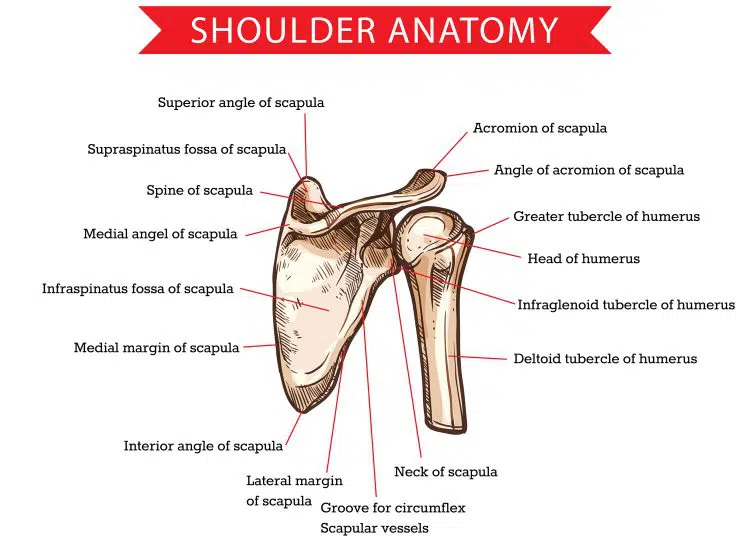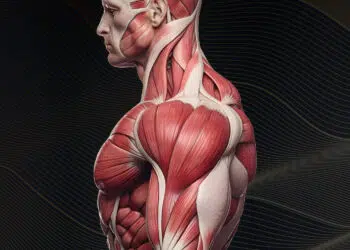Variety, they say, is the spice of life. Doing the same thing over and over again will soon lead to boredom. That’s true for the meals you eat, the clothes you wear, the job you do, and the friends you spend time with. Boredom sucks!
And yet, despite this in-built need for variety, when it comes to training, a lot of people build their workouts around the same handful of staple exercises.
Just as you’d get bored eating the same dinner every day, your muscles get bored of doing the same exercises. If you don’t challenge your muscles with new movements, your progress will slow down and could even grind to a halt.
Studies reveal that variation is as important as training intensity and volume for triggering hypertrophy (1), so it pays to change the exercises in your workouts from time to time.
In this article, we reveal 15 new exercises for bigger, wider shoulders.
Shoulder Anatomy 101
Your shoulders, correctly called the deltoids, are made up of three sets of fibers or heads. These heads work together, but it’s also possible to emphasize each one with specific movements and exercises. That’s because each deltoid head has a unique function.
Level Up Your Fitness: Join our 💪 strong community in Fitness Volt Newsletter. Get daily inspiration, expert-backed workouts, nutrition tips, the latest in strength sports, and the support you need to reach your goals. Subscribe for free!
As such, when designing your deltoid workout, it’s essential to choose the right exercise for the deltoid head you want to develop.
 Anterior deltoids
Anterior deltoids
Located on the front of your shoulders, the anterior deltoids are responsible for flexion, horizontal flexion, and internal rotation of the shoulder joint.
Of all the deltoids, this is the head most likely to be overdeveloped. Why? Because it’s involved in every chest exercise you do. Acting as a synergist or helper muscle, the anterior deltoids work whenever you do overhead presses, front raises, bench presses, push-ups, flyes, or dips. It’s a hard-worked muscle! Subsequently, a lot of lifters already have well-developed anterior deltoids.
The medial deltoids
Located on the side of your shoulders, this is the deltoid head that gives your shoulders their width. Big medial deltoids help create that V-taper that looks so good and makes your waist appear narrower. The function of the medial deltoid is the abduction of the shoulder joint. That means it raises your upper arm up and out to your side.
The posterior deltoids
Located on the back of your shoulders, the posterior or rear delts oppose the anterior deltoid. They are responsible for extension, horizontal extension, and external rotation of the shoulder joint.
While the anterior deltoid is usually the most well-developed deltoid head, the posterior deltoid is often the least developed. As such, for many lifters, this head needs extra attention.
Not training the posterior deltoid enough can affect the appearance and function of your shoulders. It’s an essential postural and stability muscle. If its development lags too far behind the anterior deltoid, the shoulder joint can become unbalanced.
15 New Exercises for Bigger, Wider Shoulders
Looking to add some variety to your deltoid workouts? You’ve come to the right place! Here are 15 new and unusual moves for bigger, broader shoulders.
1. Seated dumbbell clean and press
Regular barbell clean and presses are an excellent exercise for developing full-body strength and power. However, they are pretty lower body dominant. This seated variation hits your shoulders harder. They’re also easier to learn than full clean and presses, and you only need dumbbells and a bench to do them.
How to do it:
- Sit on the end of a bench with a dumbbell in each hand, arms by your sides. Brace your core and pull your shoulders down and back.
- Without rounding your lower back, lean forward and lower the dumbbells toward the floor.
- Sit up explosively and use this momentum to pull and lift the dumbbells up to your shoulders.
- Next, press the weights up and overhead to arms’ length.
- Lower the weights back down and repeat.
2. Incline overhead dumbbell press
This pressing variation works your posterior deltoids and mid-traps as much, if not more, than your anterior deltoids and triceps. It’s a very challenging exercise, so don’t go too heavy too soon. But, if you suffer from shoulder pain or want a delt exercise that’s also good for your posture, the incline overhead press would be a good choice.
How to do it:
- Set an incline bench to around 45-degrees. With a dumbbell in each hand, lie face down with your head uppermost. Raise the dumbbells to your shoulders, palms facing toward the floor. Pull your shoulders down and back and brace your core.
- Press the weights forward and up, so your arms form a straight line with your body.
- Return to the starting position and repeat.
3. Bradford press
The Bradford press is an old-school shoulder exercise that keeps your deltoids under constant tension. Because it involves a behind-the-neck press, it’s not an exercise for everyone. If you’ve got tight or painful shoulders, proceed with caution or skip this move entirely. But, if your shoulders are mobile and healthy, this unique exercise will provide your delts with the challenge they’ve been waiting for.
How to do it:
- Seated or standing, lift a barbell up to your shoulders, hands just outside shoulder-width apart.
- Press the weight up just high enough to clear your head. Do NOT lock your elbows.
- Lower the bar behind your neck.
- Press the bar back up and over your head and return to the front.
- That’s one rep; keep going!
4. Face pull with external rotation
Face pulls are a popular and effective rear delt exercise. However, many exercisers turn them into a glorified lat rowing exercise by using too much weight and letting their elbows drop. This variation makes it much harder to cheat and ensures your rear delts and external rotators do all the work.
How to do it:
- Attach a rope handle to a high pulley machine. Grab the handle, so your thumbs are at the end of the ropes.
- Straighten your arms and step back into a staggered stance for stability. Brace your core and pull your shoulders down and back.
- Bend your arms and pull the ends of the handles in toward your face.
- As your hands near your head, raise your hands as if you were about to pull off a double biceps pose. Your hands should be nearly level with the top of your head.
- Extend your arms and repeat.
5. Bottoms-up kettlebell press
This challenging exercise will increase shoulder stability and grip strength. You’ll also need to use your core to stabilize your spine. Don’t go too heavy too soon; this unusual shoulder pressing exercise is a lot harder than it looks!
How to do it:
- Stand with your feet shoulder-width apart, and knees slightly bent. Using one kettlebell, invert the weight and hold it in front of your shoulder, palm facing inward. Grip it tight to keep it upright. Brace your core and pull your shoulders down and back.
- Without leaning forward, backward, or sideways, press the weight up and overhead to arms’ length.
- Lower the weight back to your shoulder and repeat.
- You can also do this exercise seated and using two kettlebells instead of one.
6. Landmine lateral raise
Landmines are valuable training tools for building functional strength and muscle mass. The landmine lateral raise targets your medial deltoid but takes your arm through a slightly unusual motion to work this muscle in an all-new way. If you’re bored of dumbbell and cable lateral raises, you’ll undoubtedly enjoy this exercise.
How to do it:
- Stand side on to your landmine device. Hold the rotating sleeve with an overhand grip. Bend your knees slightly for balance, brace your core, and pull your shoulders down and back. Bend your elbow slightly but then keep it rigid for the duration of your set.
- Raise your arm up and out until your hand is roughly shoulder-level.
- Return to the starting position and repeat.
- Do the same number of reps on both sides.
7. Reactive lateral raise
This unusual exercise will literally shake up your deltoids for all-out growth! With minimal shoulder joint stress but maximal muscle activation, it’s a great way to train your delts even if you have painful shoulders.
Level Up Your Fitness: Join our 💪 strong community in Fitness Volt Newsletter. Get daily inspiration, expert-backed workouts, nutrition tips, the latest in strength sports, and the support you need to reach your goals. Subscribe for free!
How to do it:
- Tie a resistance band to a light weight plate – 5-10 pounds should be sufficient. Do the same with another identical plate. Hold a band in each hand.
- Raise your arms up and out to the side, so they form a T-shape. The weights should be clear of the floor.
- Repeatedly raise and lower your arms a few inches. The weights will bounce, forcing you to stabilize your shoulders.
- Continue for 30-60 seconds, or until you cannot keep your arms up.
8. Victory front raise
The victory front raise, sometimes known as the handcuff front raise, hits all three deltoids at the same time in one very joint-friendly exercise. Do it as a finisher at the end of your regular shoulder workout or on its own when you don’t have time to train each deltoid individually.
How to do it:
- Place a mini-band around your wrists and hold a dumbbell in each hand with your palms facing inward. Stand with your feet about hip-width apart, knees slightly bent. Brace your core and pull your shoulders down and back.
- Raise your arms forward and up overhead while simultaneously pushing your arms out to form a V-shape.
- Lower your arms but do not let the band go slack; keep some outward pressure on the band even at the bottom of each rep.
- Repeat for the desired number of repetitions.
9. Close-grip landmine overhead press
Close-grip landmine overhead presses work your deltoids, triceps, and upper chest. It’s a very shoulder-friendly exercise and an excellent alternative to barbell, dumbbell, and machine overhead presses. As it’s a standing exercise, you can do it strictly or add a little leg dip and drive to make it a push-press.
How to do it:
- Stand at the end of your landmine bar. Lift the bar up and hold it in your upturned palms. Bend your legs slightly for balance, brace your core, and pull your shoulders down and back.
- Press the bar up and overhead to arms’ length. Push your arms forward and inward to maximize muscle engagement.
- Lower the bar back to your upper chest and repeat.
- You can also do this exercise using a narrow, neutral grip handle.
10. Pin press
Pin presses force you to start each rep from a dead stop. This negates the stretch-shortening cycle (SSC), which means you’ll have to work harder to get the weight moving each time. This is a good exercise for increasing upper body pressing power.
How to do it:
- Set the safety bars in a power rack to shoulder height and rest your barbell on them.
- Without unracking the bar, grip it with an overhand, slightly wider than shoulder-width grip. Move in close to the bar with your elbows below your hands and the bar resting against your shoulders. Pull your shoulders down and back and brace your core.
- Press the barbell up and off the pins to arms’ length.
- Lower the bar back to the pins, let it settle for a second (no bouncing), and then press it up again.
- You can also do this exercise seated.
11. Trap bar overhead press
While trap bars are most commonly associated with lower body training, you can also use one for overhead presses. Using a trap bar means you can do neutral grip barbell overhead presses. As well as being a good exercise for deltoid hypertrophy, it’s also more shoulder-friendly than barbell presses and ideal for lifters with chronic joint pain.
How to do it:
- Place your trap bar in a power rack set to shoulder height and stand between the handles.
- Grab the handles with your palms facing inward.
- With your core braced, press the bar up and overhead to arms’ length.
- Lower the bar back down and repeat.
- You can do trap bar overhead presses seated or standing, and you can also use your legs for trap bar push presses.
12. Javelin press
The Javelin press is a very unusual neutral grip overhead pressing exercise. Because it’s a unilateral or one-sided exercise, it’s good for developing balance and core strength. This exercise will build your delts and teach you to stabilize your entire body, leading to increases in regular overhead and bench press performance.
How to do it:
- Place your barbell in a shoulder-height squat rack. Stand sideways onto the bar and grip the center using a neutral grip. Brace your abs and unrack the bar.
- Keeping your hips and shoulders level, press the weight up and overhead to arms’ length. Do not allow the bar to turn or tilt.
- Lower the bar back to your shoulder and repeat.
- Rerack the bar and then swap sides.
13. Dumbbell Hercules hold
This shoulder exercise is as much a test of mental strength as it is a muscle builder! Variations of the Hercules hold often feature in strongman competitions. Still, this version is much more accessible as all you need are a couple of dumbbells. This Hercules hold exercise targets your medial deltoids. Do 2-3 sets to failure as a finisher to your shoulder workout.
And yes, all that burning and shaking is entirely normal!
How to do it:
- Hold a dumbbell in each hand, arms by your sides. Stand with your feet shoulder-width apart, knees slightly bent for balance. Brace your core.
- Raise your arms up and out to the side until they’re parallel to the floor. Keep your palms facing down or point your thumbs upward as preferred.
- Hold this position for as long as you can. Don’t hold your breath!
14. Landmine shoulder to shoulder press
This shoulder, triceps, and core exercise involves a bit more coordination than the average overhead pressing exercise. As such, it’s a great way to shake up your upper body training. Add a little extra leg drive to make it a push-press for even more variety.
How to do it:
- Lift the bar and hold it in front of your chest with your hands close together, both palms facing inward. Stand with your feet about shoulder-width apart, abs braced, and shoulders down and back.
- Press the weight straight up and above your head.
- Bend your arms and lower the bar down and across to one shoulder.
- Push it back up, and then lower it to the opposite shoulder.
- Alternate shoulders for the duration of your set.
15. Top-down alternating shoulder press
This hypertrophy-specific shoulder exercise keeps your muscles under constant tension. This creates a lot of metabolic stress and a rapid build-up of lactic acid. You don’t need a lot of weight for this exercise, and that means it’s pretty shoulder-friendly.
How to do it:
- Seated or standing, raise and hold your dumbbells above your head.
- Keeping one arm straight, lower the other weight down to your shoulder and then press it back up again.
- Do your next press on the opposite side.
- Continue alternating arms until you’ve completed the desired number of reps.
- You can do this exercise with a neutral grip or your hands facing forward.
More Shoulder Workouts
- Get Bigger Shoulders Without Wrecking Your Joints
- Essential Cable Shoulder Exercises for Bigger, Stronger Deltoids
- Front Deltoid / Anterior Deltoid Exercises
- Best Shoulder Exercises For Big, Powerful Delts
- Bigger Shoulders In Less Than 30 Minutes-Session
- How to Build Bigger Shoulders: Overhead Press Hypertrophy Guide
- At-Home Shoulder Exercises For Big Gains
- Best Bodyweight Shoulder Exercises + Workout
- Infraspinatus Exercises to Strengthen Your Rotator Cuffs and Reduce Shoulder Injuries
Wrapping Up
There is nothing inherently wrong with standard overhead presses and lateral raises. But, they will gradually lose their potency if you do them too often. Your muscles will get used to these movements, which means your workouts will become less productive.
Spice up your workouts with these 15 new and unusual shoulder exercises. Each one will hit your delts in an entirely new way, retriggering hypertrophy.
Whether you are stuck in a delt-building rut or just want to avoid stalled progress in the future, start adding some of these new exercises to your workouts.
You don’t have to give up standard overhead presses and lateral raises for good. That said, supplementing those moves with any of these new exercises will ensure your deltoids keep on growing.
References:
1- PubMed: The effects of exercise variation in muscle thickness, maximal strength, and motivation in resistance-trained men https://pubmed.ncbi.nlm.nih.gov/31881066/

 Anterior deltoids
Anterior deltoids






